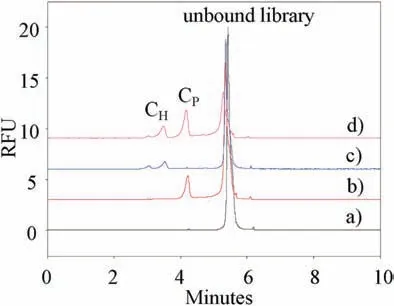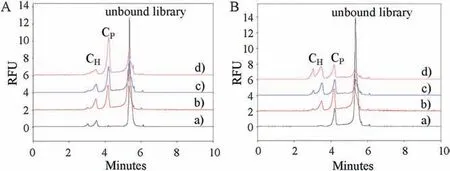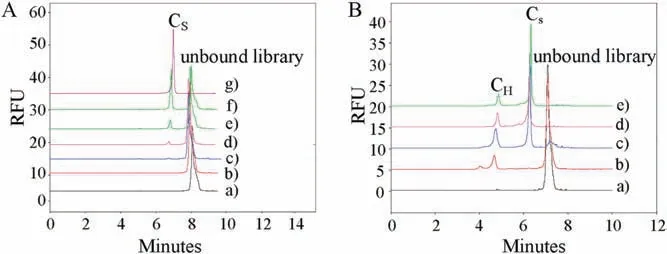Pressure controllable aptamers picking strategy by targets competition
2021-04-02GeYngChoZhuLipingZhoLinsenLiYunyuHungYukuiZhngFengQu
Ge Yng,Cho Zhu,Liping Zho,Linsen Li,Yunyu Hung,b,Yukui Zhng,Feng Qu,*
a Key Laboratory of Molecular Medicine and Biotherapy, School of Life Science, Beijing Institute of Technology, Beijing 100081, China
bAdvanced Research Institute of Multidisciplinary Science, Beijing Institute of Technology, Beijing 100081, China
c National Chromatographic Research and Analysis Center Dalian Institute of Chemical Physics, Chinese Academy of Science, Dalian 116011, China
ABSTRACT Selection of aptamers with high affinity and good specificity requires multiple rounds of alternating steps of separation and PCR amplification.Herein, we proposed a novel high-efficiency aptamers picking strategy: One-round pressure controllable selection (OPCS).OPCS integrates four types of screening superiority, high-efficiency separation, one-round selection and PCR amplification, synchronous negative selection and targets competition.The controllable screening pressure can be achieved through two approaches,balanced competition by the regulation of protein concentration,and dominant competition by introducing a predatory protein with high concentration.In OPCS process,two proteins were co-incubated with one ssDNA library,and each protein bound its favorable sequences specifically and formed protein-ssDNA complex respectively.Meanwhile,one protein could supply/suffer the picking pressure of affinity and specificity to/from another, which eliminated weakly bound or unbound sequences for each other.Two complexes could be separated and collected conveniently,and aptamers for two proteins obtained synchronously with high affinity and good specificity.This strategy not only provides a more effective way for aptamers selection,but shows great potential in other ligands or drugs selection.
Keywords:Capillary electrophoresis Aptamer selection Screening pressure controllable Targets-synchronous competition One-round selection
Aptamers are short ssDNA or RNA sequences which are capable for target molecules recognizing, and can be typically selected from a random oligonucleotide library through a process termed systematic evolution of ligands by exponential enrichment(SELEX)[1-3].This process generally involves iterated rounds of interaction between library and target, and followed by partition of complex from the unbound oligonucleotide library,and alternated steps of PCR amplification for the generation of sub-libraries till to the final sequencing [4-7].During repeat rounds, unbound and weakly bound oligonucleotides are continuously removed,and the strongly bound are retained on the targets as high-affinity candidates.To improve their specificity, negative or counter selection is also required [8-10].So, aptamers are expected to be finally obtained with significant consumption.
To accelerate the evolution, a reduced target concentration is typically used to increase"screening pressure"in repeated rounds[11-13], since lower concentration provides fewer binding sites and is helpful for strongly bound oligonucleotides surviving.However, decreasing target concentration is insufficient for increasing screening pressure in the whole comprehensive selection process.More screening pressures have to be considered.(1) Separation efficiency. High-efficiency separation determines the effective elimination scope of unbound and weakly sequences,which provides stronger screening pressure to speed up the evolution [4].(2) Repeat rounds.Undesired sequences are eliminated in the continuous iterative interaction between the target and sub-libraries [14].(3) Negative and counter selection.Negative or counter selection eliminates the non-specific binding sequences through competition [9].(4) Target concentration.Either reducing the aim target concentration or increasing the counter target concentration provides higher screening pressure.
Most of the current selection works involve in employing efficient separation methods, reducing target concentration,introducing counter targets,or performing more screening rounds to strengthen screening pressure.However, these methods generally require multi-rounds selection and repeated PCR amplification, which causes serious preferential amplification and base mispairing [15-17].Error reading of evolutional highaffinity sequence distorts the original aptamers candidates [18].Although several reports have claimed one-round selection[14]or non-SELEX [19-21] can improve the screening efficiency by reducing PCR process, however, it has been suspected for the imperfection of screening pressure.Till now, it remains challenging to synchronously control multi-screening pressure in aptamer selection.

Fig.1.Schematic of OPCS by two targets competition and one-run capillary electrophoresis (CE) separation.
Herein, we present a novel high-efficiency aptamers picking strategy: one-round pressure controllable selection (OPCS), in which multiple screening pressure were integrated.OPCS scheme is depicted in Fig.1.In OPCS process,two proteins(A and B)were co-incubated with one ssDNA library in a vial, in which each protein bound its favorable sequences specifically and formed its respective protein-ssDNA complex,meanwhile,one protein could supply/suffer the picking pressure of affinity and specificity to/from another, which eliminated weakly bound or unbound sequences for each other.Meanwhile, the screening pressure can be controlled through two approaches: Adjusted the proportion of target proteins,and dominant competition by introducing a predatory protein with high concentration.After incubation, the equilibrium mixture is injected into capillary and completed highresolution capillary electrophoresis separation of unbound sequences and each complex [22-25] (Fig.1).Through the collection of each complex fraction, PCR amplification and sequencing, aptamer candidates against protein A and B would be selected simultaneously.
Human holo-transferrin (H-Tf) and platelet derived growth factor-BB(PDGF-BB)were introduced as model proteins to perform the proof of concept of OPCS.In Fig.2,the single peak of 0.2 μmol/L ssDNA library was observed at 5.28 min (curve a).After the addition of 0.4 μmol/L PDGF-BB or 0.4 μmol/L H-Tf in ssDNA library,complex peaks of CPpeak at 4.17 min(curve b)and CHpeaks of 3.0 and 3.5 min (curve c) were found, respectively, while the ssDNA peak decreased apparently.When H-Tf, PDGF-BB, and library were co-incubated with two proteins (curve d),both the CPand CHpeaks appeared( curve d)indicated that two complexes of PDGF-BB/ssDNA and H-Tf/ssDNA were formed,thus simultaneous selection for two targets was feasible.It is worth noting that only H-Tf was incubated with ssDNA,there were two peaks appeared at 3.0 and 3.5 min, which was attributed to the formation of complexes with different mass-to-charge ratio.

Fig.2.Electropherograms of the separation of complexes and unbound library. Curve: a) 0.2 μmol/L ssDNA, b) a+0.4 μmol/L PDGF-BB, c) a+0.4μmol/L H-Tf, d)a+0.4μmol/L H-Tf+0.4μmol/L PDGF-BB.CE separation conditions: 50 mol/L H3BO3/Na2B4O7 buffer, pH 8.7, 498 V/cm and 25°C.5 s/0.5 psi injection, LIF detection with excitation/emission at 488/520 nm.

Fig.3.Balanced competition binding of H-Tf, PDGF-BB and ssDNA library.(A)Keeping the constant concentration of H-Tf and increasing PDGF-BB (0.4-1.2 μmol/L).Curve:a)0.2 μmol/L ssDNA+0.4 μmol/L H-Tf,b)a+0.4 μmol/L PDGF-BB,c) a + 0.8 μmol/L PDGF-BB, d) a +1.2 μmol/L PDGF-BB.(B) Keeping the constant concentration of PDGF-BB and increasing H-Tf(0.4-1.2 μmol/L).Line:a)0.2 μmol/L ssDNA+0.4 μmol/L PDGF-BB,b)a+0.4 μmol/L H-Tf,c)a+0.8 μmol/L H-Tf,d)a+1.2 μmol/L H-Tf.
Further,the dynamic competitive binding of two target proteins was demonstrated.In Fig.3A, keeping the concentration of H-Tf constant at 0.4 μmol/L accompanied by an increasing PDGF-BB concentration from 0.4 μmol/L to 1.2 μmol/L, and the results showed a reduction of CHpeak, suggesting that PDGF-BB competitively bound ssDNA from H-Tf complex.Similarly,increasing H-Tf concentration also resulted in the peak area decrease of CP(Fig.3B).These results indicated that different proportion of two proteins produces adjustable competing pressure.Apparently,the balance pressure of two targets can be generated by employing an equal concentration of two proteins,as a result,aptamers for two proteins can be obtained synchronously.The complexes of CHand CPfractions were collected separately (Fig.S1 in Supporting information).Through one PCR and high-throughput sequencing,seven aptamer candidates(Apt H1~7)for H-Tf and seven for PDGFBB (Apt P1~7) were picked out (Table S1 in Supporting information), whose affinities and secondary structures were characterized and listed in Fig.S2 (Supporting information).The aptamers with the highest affinity for PDGF-BB(Apt P3,KD=0.081±0.018 μmol/L)and for H-Tf(Apt H6,KD=0.050±0.015 μmol/L)were synchronously obtained.To assess their specificity,their KDof two sequences of H-Tf and PDGF-BB against their competitor were determined.Fig.S3 (Supporting information) showed that Apt H and Apt P presented stronger affinity for its aim target far more than the competitor protein.Moreover,the target-aptamer binding showed excellent linearity (Fig.S4 in Supporting information).Above results suggested that balance pressure could be employed for two proteins selection with their equal concentration in one OPCS process.

Fig.4.Dominant competition binding of H-Tf, SSB, and ssDNA library.(A) SSB binding ssDNA library. Curve:a-g)0.4 μmol/L ssDNA library+0.0,0.2,0.4,1.0,2.0,3.0,4.0 μmol/L SSB;(B)H-Tf and SSB compete for binding ssDNA library.Line:a)0.2 μmol/L ssDNA+0.4 μmol/L H-Tf,b)a+1.0 μmol/L SSB,c)a+2.0 μmol/L SSB,d)a+3.0 μmol/L SSB.
Furthermore,if one target is at a dominant high concentration,more binding sites could be provided to compete for more ssDNA sequences.Hence, the target in lower concentration suffers a severe competitive pressure of the dominant competitor, which would facilitate the survival of the sequences with high affinity and specificity.
The dominant screening pressure can also be accomplished through introducing a predatory competitor.Single strand DNAbinding protein (SSB) is an ssDNA binding protein with a nanomolar KDwith no sequence selectivity, which was used as the predator for H-Tf in OPCS.Fig.4A showed that 4.0 μmol/L SSB can bind almost all the sequences when it was incubated with ssDNA library.When 0.2 μmol/L SSB and 0.4 μmol/L H-Tf were coincubated,both complex peaks of CHand CSappeared separately at about 4.7 min and 6.2 min (Fig.4B, curve b).Increasing SSB concentration to 1.0 μmol/L,ssDNA peak reduced significantly,and a large CSpeak appeared accompanied with an apparent CHpeak decrease (Fig.4B, curve c).When adding another 2.0-3.0 μmol/L SSB(Fig.4B,curves d and e),ssDNA peak disappeared with further increscent CSpeak.With concomitant reducing of CHpeak,SSB has shown extraordinary ability to combine ssDNA competitively.
During the OPCS process, concentration ratio of SSB and H-Tf reached 15:2,under which the peak area of CHno longer decreased,suggesting that SSB competitive binding ssDNA from CHhas reached the maximum.In this case, the remained ssDNA in complex CHhas the potential of higher affinity and specificity.Collecting complex CHfraction(Fig.S5 in Supporting information)and performing one PCR amplification and sequencing, ten aptamer candidates of Apt H'1-10 were picked (Table S2 in Supporting information), they all have nanomolar KDvalues(Fig.S6 in Supporting information).Apt H'9 and Apt H'10 have extremely low KDvalues of 0.003± 0.001μmol/L and 0.005±0.001μmol/L, respectively.Under the maximum competing pressure generated from the high concentration and predatory binding capacity of SSB,the affinity of Apt H'improved more than a 10-fold compared with that in balance competing pressure.Their KDof Apt H and Apt H'were shown in Figs.S2 and S6.Besides,the KDvalues of Apt H'1 and Apt H'2 for H-Tf in Fig.S7 (Supporting information) showed 1-2 orders of magnitude lower than that of SSB, which indicated their good specificity for H-Tf.The results demonstrated that employing a dominant competitor in OPCS process could improve the performance of aptamer candidates.
In this study,the OPCS strategy was proposed for the first time,which realized multi-screening pressure controllable through two approaches of balanced competition by equal protein concentration, and dominant competition by a predatory protein with high concentration.Target proteins H-Tf,PDGF-BB and SSB were used as model proteins, aptamers with high affinity and good specificity were obtained by one round selection.Besides,we have performed aptamers selection of Rec A, LZM, Cas9 and OGG1 (Fig.S8 in Supporting information)to confirm the feasibility and universality of OPCS.Our results show the OPCS strategy greatly improves the aptamers selection efficiency with advantageous of less consumption and time.This strategy not only performs a more effective way for aptamers selection, but shows great potential in other ligands or drugs selection.
Declaration of competing interest
The authors report no declarations of interest.
Acknowledgments
We thank the support of the National Natural Science Foundation of China (Nos.21675012, 21874010 and 21827810),and the Young Elite Scientist Sponsorship Program of Beijing Association for Science and Technology.There are no conflicts to declare.
Appendix A.Supplementary data
Supplementarymaterialrelatedtothisarticlecanbefound,inthe online version,at doi:https://doi.org/10.1016/j.cclet.2020.10.018.
杂志排行
Chinese Chemical Letters的其它文章
- Diverse synthesis of the C ring fragment of bryostatins via Zn/Cu-promoted conjugate addition of α-hydroxy iodide with enone
- Directly conversion the biomass-waste to Si/C composite anode materials for advanced lithium ion batteries
- Mechanism and selectivity of copper-catalyzed borocyanation of 1-aryl-1,3-butadienes: A computational study
- Recent advances in the improvement of g-C3N4 based photocatalytic materials
- In-situ electro-deposition synthesis of MnOx-NiCo2O4 monolithic catalyst with rich phase interfaces
- Aconapelsulfonines A and B, seco C20-diterpenoid alkaloids deriving via Criegee rearrangements of napelline skeleton from Aconitum carmichaelii
